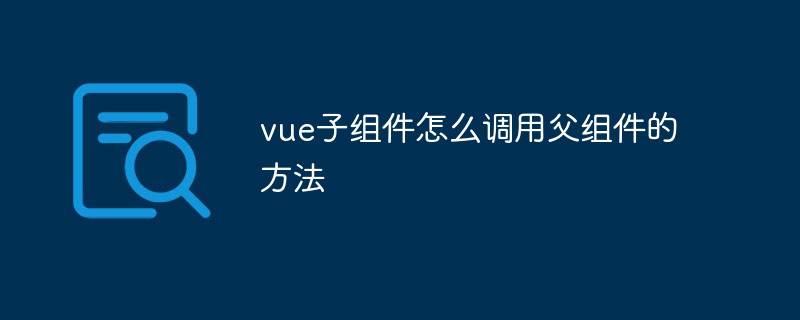vue 하위 구성 요소는 상위 구성 요소의 메서드를 어떻게 호출합니까?
- 青灯夜游원래의
- 2021-10-26 12:03:28124927검색
메서드: 1. 하위 컴포넌트의 "this.$parent.event"를 통해 상위 컴포넌트의 메소드를 호출합니다. 2. 하위 구성 요소는 "$emit"를 사용하여 상위 구성 요소에 대한 이벤트를 트리거하고 상위 구성 요소는 이 이벤트를 수신할 수 있습니다. 3. 상위 컴포넌트는 하위 컴포넌트에 메소드를 전달하며, 해당 메소드는 하위 컴포넌트에서 직접 호출할 수 있습니다.

이 튜토리얼의 운영 환경: Windows 7 시스템, vue 버전 2.9.6, DELL G3 컴퓨터.
Vue에는 하위 컴포넌트에서 상위 컴포넌트를 호출하는 세 가지 방법이 있습니다. 참고로 세 가지 방법이 있습니다
첫 번째 방법은 this.$parent.event를 통해 상위 컴포넌트를 직접 호출하는 것입니다. 하위 구성 요소
상위 구성 요소
<template>
<p>
<child></child>
</p>
</template>
<script>
import child from '~/components/dam/child';
export default {
components: {
child
},
methods: {
fatherMethod() {
console.log('测试');
}
}
};
</script>하위 구성 요소
<template>
<p>
<button @click="childMethod()">点击</button>
</p>
</template>
<script>
export default {
methods: {
childMethod() {
this.$parent.fatherMethod();
}
}
};
</script>두 번째 방법은 하위 구성 요소에서 $emit를 사용하여 상위 구성 요소에 대한 이벤트를 트리거하고 상위 구성 요소는 이 이벤트를 수신할 수 있습니다.
부모 구성 요소
<template>
<p>
<child @fatherMethod="fatherMethod"></child>
</p>
</template>
<script>
import child from '~/components/dam/child';
export default {
components: {
child
},
methods: {
fatherMethod() {
console.log('测试');
}
}
};
</script>자식 구성 요소
<template>
<p>
<button @click="childMethod()">点击</button>
</p>
</template>
<script>
export default {
methods: {
childMethod() {
this.$emit('fatherMethod');
}
}
};
</script>세 번째 방법은 부모 구성 요소가 메서드를 자식 구성 요소에 전달하고 이 메서드를 자식 구성 요소에서 직접 호출하는 것입니다.
부모 구성 요소
<template>
<p>
<child :fatherMethod="fatherMethod"></child>
</p>
</template>
<script>
import child from '~/components/dam/child';
export default {
components: {
child
},
methods: {
fatherMethod() {
console.log('测试');
}
}
};
</script>자식 구성 요소
<template>
<p>
<button @click="childMethod()">点击</button>
</p>
</template>
<script>
export default {
props: {
fatherMethod: {
type: Function,
default: null
}
},
methods: {
childMethod() {
if (this.fatherMethod) {
this.fatherMethod();
}
}
}
};
</script>[관련 추천: vue.js tutorial]
위 내용은 vue 하위 구성 요소는 상위 구성 요소의 메서드를 어떻게 호출합니까?의 상세 내용입니다. 자세한 내용은 PHP 중국어 웹사이트의 기타 관련 기사를 참조하세요!
성명:
본 글의 내용은 네티즌들의 자발적인 기여로 작성되었으며, 저작권은 원저작자에게 있습니다. 본 사이트는 이에 상응하는 법적 책임을 지지 않습니다. 표절이나 침해가 의심되는 콘텐츠를 발견한 경우 admin@php.cn으로 문의하세요.
이전 기사:Vue 컴포넌트란 무엇인가요?다음 기사:Vue 컴포넌트란 무엇인가요?

